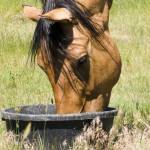Feeding Horses: Meals Per Day

A horse’s gastrointestinal tract functions optimally when it is processing forages. Slow, steady consumption of pasture, hay, or other forage sources has several advantages, including keeping the stomach filled to prevent ulcer formation and nourishing the microorganisms of the hindgut. Energy requirements often dictate that additional calorie sources, typically concentrates, be fed to sustain growth or performance. How often should concentrates be fed for optimal health?
“The amount of feed needed to fuel growth or work is the primary factor in determining how many meals a horse should be fed daily,” said Catherine Whitehouse, M.S., a nutritionist for Kentucky Equine Research. “While forage should be available to horses at all times, or nearly so, concentrates are best offered as small meals, usually no more than 5 lb (2.3 kg) at a time for mature horses.”
Why cap the amount of grain in a meal? “It’s a matter of stomach size and rate of digestion,” said Whitehouse. “Most horses would be pleased to have several huge grain meals a day, but the gastrointestinal tract can only manage so much at one time, both physically and physiologically.”
Because starch is the primary energy source in many feeds, it must spend adequate time in the small intestine to be digested properly. If pushed through the small intestine too rapidly, the starch enters the hindgut incompletely digested. “Starch overload of the hindgut can be problematic, as it causes a drop in pH which, in turn, can be harmful to the beneficial microorganisms that help ferment forage. Any roadblock in forage fermentation can interfere with energy production.”
If you’re feeding about 5 lb (2.3 kg) of feed a day to horse, then he can be safely fed in one meal. Most fortified concentrates are formulated to be fed at a level of intake between 6 and 13 lb (3 and 6 kg) per day, so multiple meals are needed. For horses that consume more than 10 lb (4.5 kg) of concentrate per day, it is best to offer it in three meals spread evenly throughout the day.
Even when fed three meals a day, some horses are sensitive to starch moving into the hindgut. Disruptions in the pH balance can be prevented through the use of a hindgut buffer, such as EquiShure. “EquiShure was specifically engineered to help horses with hindgut acidosis,” said Whitehouse. “The product contains a protective layer that keeps the buffer from being released until it hits the hindgut. With its time-release mechanism, EquiShure has been a game-changer when it comes to hindgut health.”
Is your horse’s gastrointestinal health up to snuff? Consult with a Kentucky Equine Research nutrition advisor to make sure your horse is getting the most from its diet.








